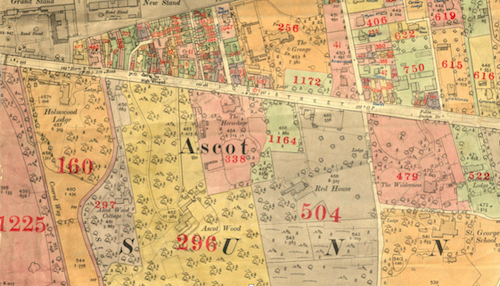The following announcement was written by the folks at TheGenealogist:
More than 185,000 new Lloyd George Domesday land tax records have been added by TheGenealogist to its Landowner and Occupier records. Consisting of records from the counties of Berkshire and the Buckinghamshire, this release provides researchers with the ability to discover owners and occupiers of property in the period 1910 to 1915.
 IR126 Map of Ascot on TheGenealogist’s Map Explorer™
IR126 Map of Ascot on TheGenealogist’s Map Explorer™
Covering an area of over 800 square miles, researchers can use these records to see the size, state of repair and value of the house in which their ancestors had been the landlord of, or had lived in.
TheGenealogist has linked all the records to the large scale Ordnance Survey maps that were used at the time.These detailed maps show each property plotted on detailed mapping that can be viewed with TheGenealogist’s Map Explorer™ tool. This interface will show the same coordinates on a variety of modern and historical maps. Using this allows house or family historians to see how the area they are researching may have changed over time and with it to then explore their ancestors' locality.
- Details of Individual properties can be found in these Lloyd George Domesday records
- Records are linked to extremely detailed maps used in 1910-1915 and viewable on the powerful Map Explorer™
- Ability to fully search the records by a person’s name, county, parish and street
- The Ordnance Survey maps zoom down to show individual properties
- Georeferenced to a modern street map or satellite map underlay the researcher can more clearly understand what the area looks like today
Areas covered in this release include:
Aldermaston, Aldworth, Amersham, Arborfield, Ardington, Ashampstead, Ashley Green, Barkham, Basildon, Beaconsfield, Beech Hill, Beedon, Beenham, Binfield, Bisham, Bledlow, Blewbury, Boveney, Boxford, Bradenham, Bradfield, Bray, Brightwalton, Brimpton, Buckland, Bucklebury, Burghfield, Burnham, Catmore, Caversham, Chaddleworth, Chalfont St Giles, Chalfont St Peter, Challow (East and West), Charlton, Chenies, Chepping Wycombe, Chesham, Chieveley, Childrey, Chilton, Cholesbury, Clewer Within, Clewer Without, Cold Ash, Compton, Cookham, Crowthorne, Datchet, Denchworth, Denham, Donnington, Earley, East Garston, East Ilsley, East Lockinge, East Shefford, Easthampstead, Ellesborough, Enborne, Englefield, Eton, Farnborough, Farnham Royal, Fawley, Fawley, Fawley, Finchhampstead, Fingest, Frilsham, Fulmer, Gerrards Cross, Goosey, Grazeley, Great Coxwell, Great Missenden, Greenham, Grove, Hambleden, Hampden (Great and Little), Hampstead Marshall, Hampstead Norris, Hanney (East and West), Harwell, Hawridge, Hedgerley, Hedsor, Hendred (East and West), High Wycombe, Hitcham, Horsenden, Horton, Hungerford, Hurley, Ibstone, Ilmer, Inkpen, Iver, Kimble (Great and Little), Kintbury, Lambourn, Langley, Leckhampstead, Lee, Letcombe Bassett, Letcombe Regis, Little Marlow, Little Missenden, Maidenhead, Marlow, Medmenham, Midgham, Mortimer, New Windsor, Newbury, Newland, Old Windsor, Pangbourne, Peasemore, Penn, Princes Risborough, Remenham, Ruscombe, Sandhurst, Saunderton, Shaw, Shinfield, Shottesbrook, Slough, Slough, Sparsholt, Speen, St Giles, St Lawrence, St Mary, St Nicholas Hurst, Stanford Dingley, Streatley, Sunningdale, Sunninghill, Swallowfield, Taplow, Thatcham, Theale, Tilehurst, Towersey, Turville, Twyford, Upton, Waltham St Lawrence, Wantage, Warfield, Wargrave, Welford, West Ilsley, West Shefford, West Woodhay, White Waltham, Winkfield, Winnersh, Winterbourne, Wokingham, Wooburn, Woolhampton & Yattendon
Read TheGenealogist’s article: To the Cottage Born https://www.thegenealogist.co.uk/featuredarticles/2022/to-the-cottage-born-1645/
About TheGenealogist
TheGenealogist is an award-winning online family history website, who put a wealth of information at the fingertips of family historians. Their approach is to bring hard to use physical records to life online with easy to use interfaces such as their Tithe and newly released Lloyd George Domesday collections.
TheGenealogist’s innovative SmartSearch technology links records together to help you find your ancestors more easily. TheGenealogist is one of the leading providers of online family history records. Along with the standard Birth, Marriage, Death and Census records, they also have significant collections of Parish and Nonconformist records, PCC Will Records, Irish Records, Military records, Occupations, Newspaper record collections amongst many others.
TheGenealogist uses the latest technology to help you bring your family history to life. Use TheGenealogist to find your ancestors today!
 Latest News Articles
Latest News Articles Do you have an RSS newsreader? You may prefer to use this newsletter's RSS feed at:
Do you have an RSS newsreader? You may prefer to use this newsletter's RSS feed at: